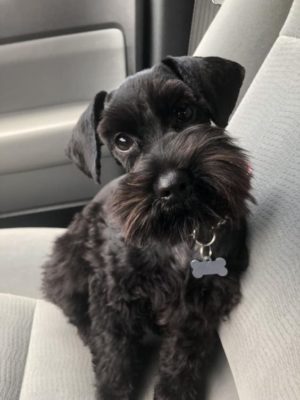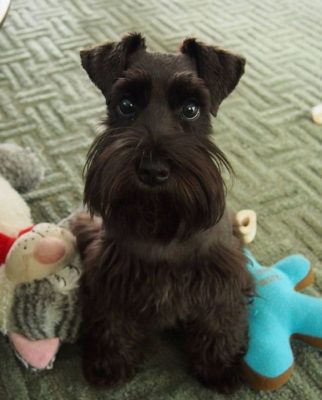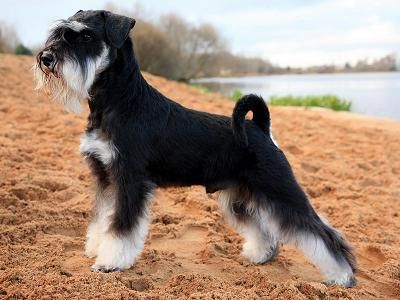Miniature Schnauzer

The Zwergschnauzer has inherited many characteristic traits from its relative, the Schnauzer. They have a rapid reaction, brave, ready to defend their household. They love children, willingly spend a lot of time with them, and play. Miniature Schnauzer black is brilliant, always ready to serve, hardworking. He can be easily taught commands.
Table of Contents
Breed Information
| Another Name | Zwergschnauzer (Dwarf Schnauzer) |
| Origin | Germany |
| Height | 30-35 cm |
| Weight | 4-8 kg |
| Fur | Very stiff and thick |
| Color | Pure black with a black undercoat, pepper, and salt, black and silver, pure white with a white undercoat |
| Lifespan | 12-15 years |
| FCI Classification | Pinscher and Schnauzer – Molossoid and Swiss Mountain and Cattledogs |
| Group | Watchdogs, dogs for children, small breed dogs, or decorative dogs |
| Price | $300-1000 |
Breed Photos
Origin History
The Miniature Schnauzer (Zwergschnauzer) is descended from the Mittelschnauzer, crossed with small dogs such as the Zwergpinscher, Affenpinscher. The breed was bred to have the character of a schnauzer, but at the same time, the small size helped them live easily in urban environments.
In 1898, the first official representative of the breed, the cable Jockey Fulda Lilliput, was born. Now the Miniature Schnauzer species is considered one of the most popular in the United States and Europe, as its miniature size makes it possible to keep the dog in an apartment.
Appearance
The Zwergschnauzer resembles a scaled-down copy of a schnauzer. The dog has a healthy body with a square shape. The height of the Zwergschnauzer at the withers is about 30-35 cm; the weight can be from 4 to 8 kg.
The hair of the dog is very stiff and quite thick. There is also a dense undercoat, which fits nicely on the body. The coat is not wavy, relatively straight, long enough. It is not very stiff on the paws. The forehead and ears have short hair. The muzzle has a beard and eyebrows above the eyes, which is a typical breed sign.
Color can be solid black with a black undercoat, can be color “pepper and salt,” black with silver spots, pure white with the same white undercoat.
The pet’s teeth are snow-white and robust. The tail used to be popular to cut, but now it is recommended to leave the natural length.
Character
The Zwergschnauzer has inherited many characteristic traits from its relative, the Schnauzer. They have a rapid reaction, brave, ready to defend their household. They love children, willingly spend a lot of time with them, and play.
Miniature Schnauzer black is brilliant, always ready to serve, hardworking. He can be easily taught commands. In representatives of the breed, security qualities are well developed. At first, the Zwerschnauzer warns strangers by barking loudly, and if that does not work, it can bite.
It isn’t very friendly to cats, but if they are introduced in the early stages of the dog’s life, it is easy for them to share territory afterward. The Zwerschnauzer does not tolerate loneliness and continually needs someone to be with him. If the pet decides he is ignored and avoided by family members, it will make his character much worse. They try to please their owner all the time and need praise and affection.
Care
Miniature Schnauzers can easily be kept in an urban apartment, but it is worth remembering to take regular walks outdoors about three times a day. The dog likes to play with small things and may reluctantly destroy household items. Therefore, it is advisable to hide all articles that may interest the pet during playtime. It is important to remember that it is essential for the Miniature Schnauzer to spend as much time with family members as possible.
During the molting period, trimming twice a year is recommended. The hair on the head, ears, and neck are cut with special scissors not to hurt the animal.
Every day you should brush his coat, trim his nails regularly, wipe his eyes and check his ears for cleanliness. After walks, you can wipe dirt off the paws. Teeth should be brushed once a week to prevent disease.
Training
It is recommended to train from an early age, from about three months old, the puppy is already smart enough to remember commands. From the first day of living in the house, Miniature Schnauzers should be taught discipline and not make any exceptions. If you don’t want your dog to sleep in the same bed with you, you should never let him. If the dog makes achievements and performs the tasks assigned to him, be sure to praise him, and after successful training, you can reward him with something tasty.
It is worth training your pet on the playground, but not at home. A change of scenery has a positive effect on physical activity. Walking up to the garden, the dog will know from memory that training is waiting for him.
Common Diseases
Miniature Schnauzers can have diseases such as:
- allergies;
- hypothyroidism;
- melanoma;
- glaucoma;
- cataract;
- diabetes;
- pancreatitis.
Nutrition
Can eat food, but it is better to give natural food. The diet should be balanced and consist of meat, cereals, vegetables, fish, dairy products, fruits. Meat and fish should preferably be raw. Adult Miniature Schnauzer should be fed twice a day.
 East European Shepherd
East European Shepherd Shar Pei
Shar Pei Akita
Akita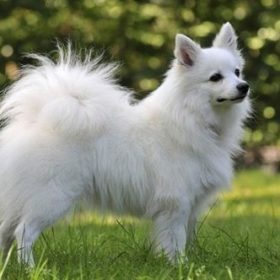 Volpino Italiano
Volpino Italiano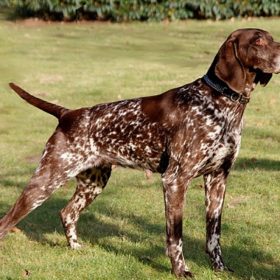 German Shorthaired Pointer
German Shorthaired Pointer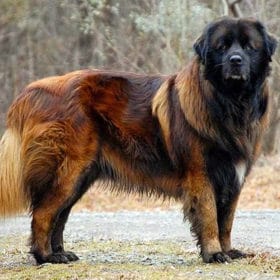 Estrela Mountain Dog
Estrela Mountain Dog